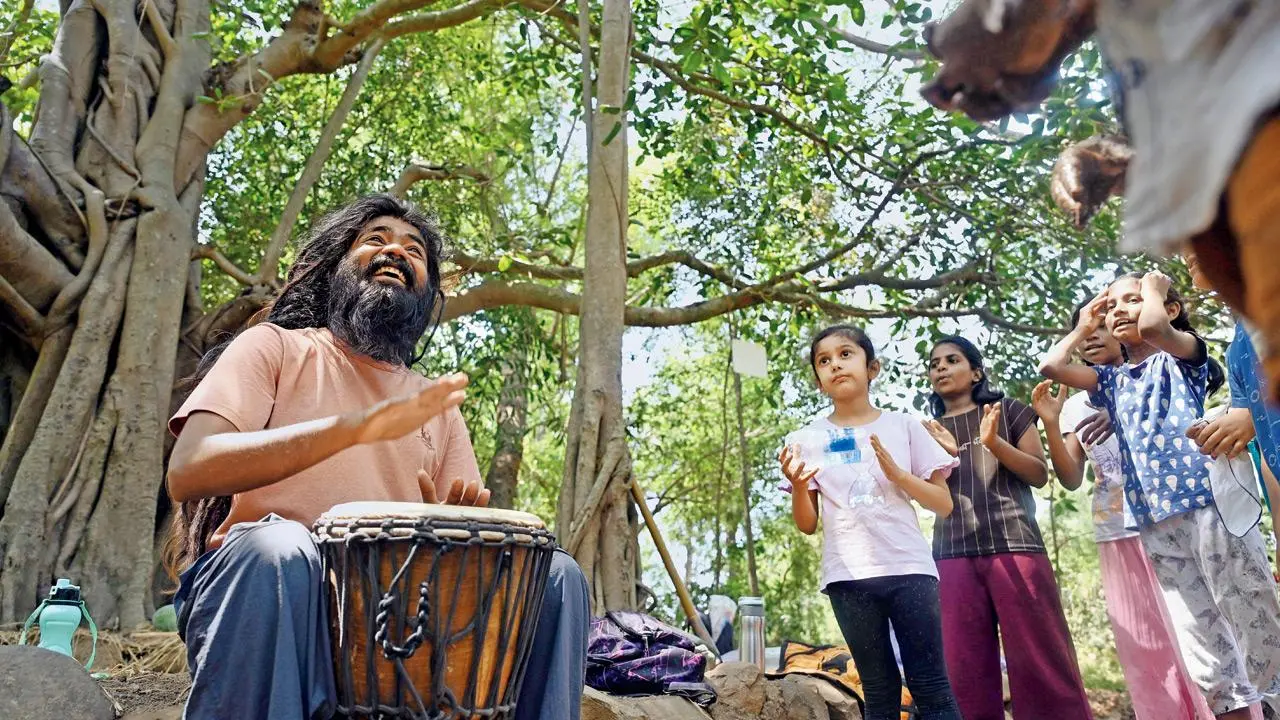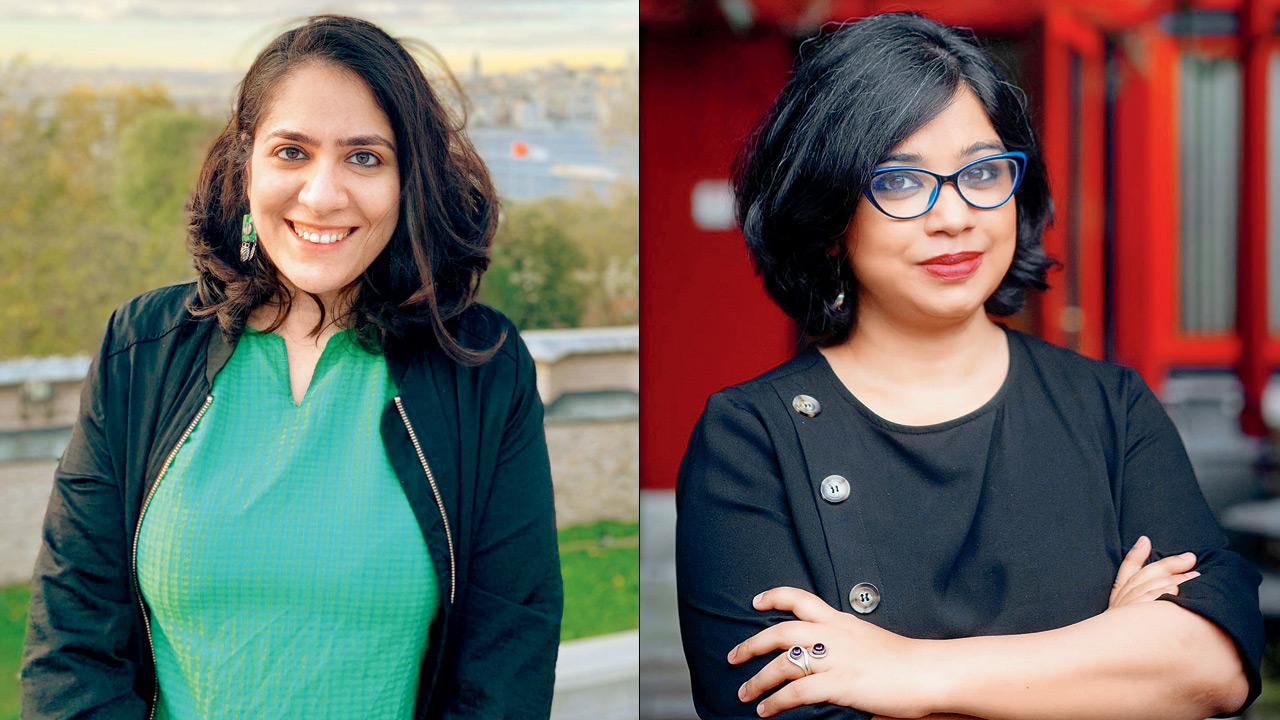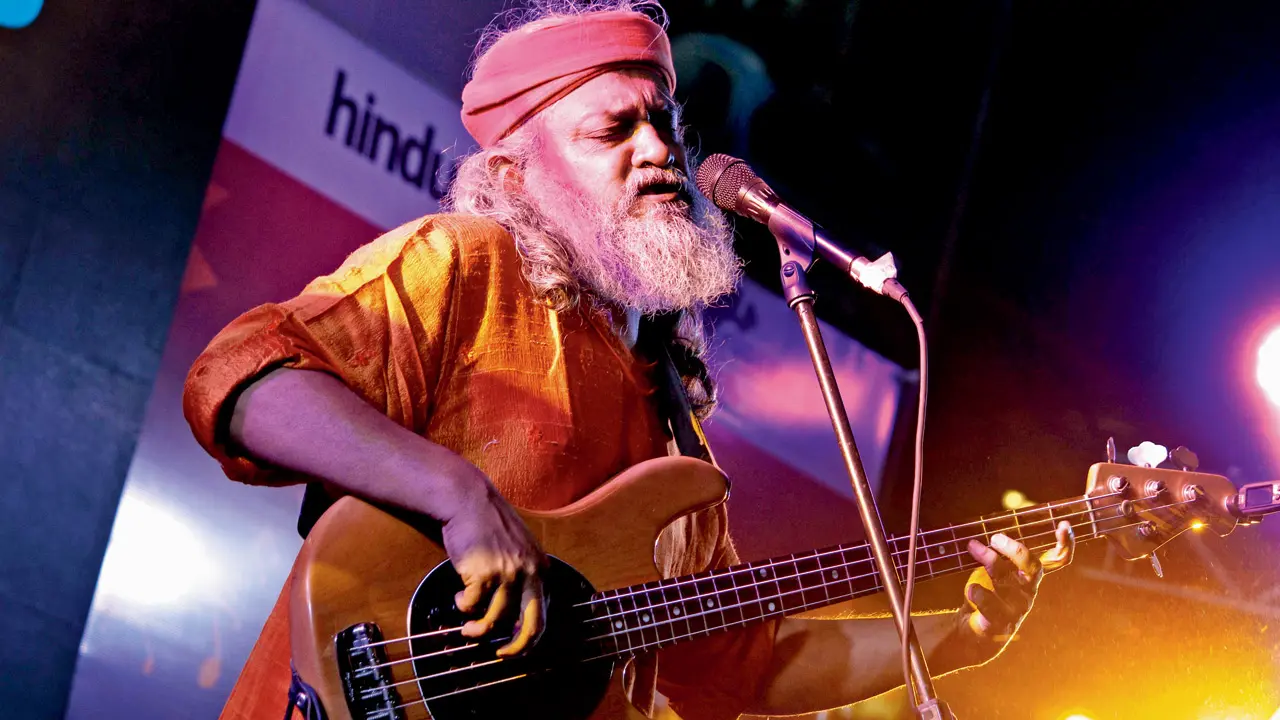Musicians across the world are increasingly using their platforms to raise awareness about environmental issues, blending artistry with activism to inspire change

Since leaving his job, Elijah Emmanuel has sustained himself through his grassroots music school called Seeds of Banyan in the Aarey forest area, aimed at connecting young people with nature, in hopes that this bond fosters respect and care for the environment. Pic/Satej Shinde
Aditi Veena, a singer-songwriter who goes by the stage name Ditty, 35, lost her father about 12 years ago to interstitial lung disease. At the time, she didn’t fully understand it, but later, as she read more, she learned that environmental factors such as dust, chemicals, and air pollution can play a big role in causing it.
Music became a way for her to cope with the loss, to build meaning around it. “I made peace with his absence by believing that he had become one with the earth — that I could find him in everything, and within myself. That idea gave me a powerful beginning in songwriting,” says the urban ecologist now based in Germany. Ditty has become known for her introspective, ecologically conscious music — a blend of poetry, acoustic textures, and ambient soundscapes which is reflected in her albums Poetry Ceylon and KĀLĪ .

Aditi Veena, a singer-songwriter who goes by the stage name Ditty has become known for her introspective, ecologically conscious music — a blend of poetry, acoustic textures, and ambient soundscapes
Over time, that deeply personal beginning evolved into a more expansive vision that sought to address ecological decline, loss, and resilience through song. “I wanted to speak about topics that were becoming taboo. For instance, my song Eulogy for a Sparrow reflects on how sparrows disappeared from Delhi, which is where I grew up.” Another song of hers, On an Island, talks about the pressures cities in the Global South face from corporations, governments, overpopulation, and environmental degradation.
These aren’t abstract concerns. According to UN-Habitat, the world generates between 2.1 and 2.3 billion tonnes of municipal solid waste each year — from food to plastics to electronic waste. “It’s a weight the planet can’t carry alone,” notes Ditty.
Musicians across the world are increasingly using their platforms to raise awareness about environmental issues, blending artistry with activism to inspire change. Renowned artistes like Billie Eilish and Coldplay have incorporated the ideas of eco-consciousness into their performances and actions.
When Coldplay announced their Music of the Spheres Tour in 2021, they had pledged to reduce their direct carbon emissions by at least 50 per cent. Earlier this year, they reported that their direct CO2 emissions from the first two years of this tour were 59 per cent less than their previous stadium tour in 2016-17.
Closer to home, Elijah Emmanuel — music artiste, educator, and active participant in the Save Aarey movement — embodies this fusion of music and environmental consciousness. “For me, music has always been healing. It soothes me, grounds me. And through my teaching, I share the philosophy that music is a healing force and a tool for unity,” he says.
Emmanuel runs a music school for children in the Aarey forest area, Seeds of Banyan, where he uses nature itself as a classroom. “During the lockdown, I began teaching under a banyan tree when I realised many local children couldn’t access online education. That space became a sanctuary.” His work highlights the disconnect between children who are academically confident but distant from nature, and those who are rooted in the land but lack platforms for expression. 
Radha Kapuria and Priyanka Basu
In India, environmental themes have long resonated through music, woven into the cultural fabric of various regions. “The power of music to express ecological concerns isn’t new — it’s deeply rooted in the country’s history. Songs have long been tools of protest and consciousness-raising,” says Radha Kapuria, Assistant Professor of South Asian History at Durham University, UK. Kapuria and Priyanka Basu, an Assistant Professor of Performing Arts at King’s College London, are co-editors of a book, Performing Nature: Ecology and the Arts in South Asia, that explores how performance practices intersect with environmental thought.
One chapter from the volume, authored by Ihsan Ul-Ihthisam and Rohini Menon, examines how song emerges in times of crisis, focusing on flood songs from the Malabar region — spiritual and ecological laments rooted in Arabic and Malayalam traditions. “In the world of Punjabi pop, songs like Sajjad Ali’s Ravi, centred around the metaphor of the river, has poignant connections with movements to save the endangered Ravi floodplains; while the late Sidhu Moosewala’s SYL on the contentious Punjab-Haryana water-sharing dispute, shows how even popular music can elevate environmental awareness,” Kapuria notes.
Meanwhile, artistes like Rahul Ram of Indian Ocean — with his PhD in environmental toxicology influencing his folk-rock music — prove that activism and art are not only compatible but powerful together. “Music doesn’t cause change by itself,” Ram says. “It gives people a shared message. That’s why we call it an anthem.”

Rahul Ram of Indian Ocean — with his PhD in environmental toxicology influencing his folk-rock music — proves that activism and art are not only compatible but powerful together. FILE PIC/GETTY IMAGES
Basu adds, “From our vantage point as educators, we witness music as a unifying force in everyday activism and advocacy. Whether in picket lines outside universities during industrial action or in general protest rallies/sit-ins globally, music and instrument-playing bring people together. It creates shared space — between young and old protesters such as 18-year old students and senior academics — in solidarity.”
Basu cites the example of filmmaker and tribal rights activist from Chhattisgarh. Biju Toppo, who echoes this connection between artistic expression and the earth.
His Kurukh-language documentary Sona Gahi Pinjra captures the deep consciousness of tribal communities in Jharkhand. “For communities like the one depicted in the film — whose lives are so rooted in jal, jungle, jameen (the cornerstone of the Pathalgadi Movement in Jharkhand) — to talk is to sing, and to walk is to dance,” Toppo said during a recent screening of the film in London, according to Basu.
Another chapter of the book, authored by Buddhaditya Bhattacharya, explores how climate change affects even the materials that make music. He writes about the Kolkata tanpura, an instrument made from gourds, which are hard-shelled fruits. As climate change impacts gourd agriculture, it also affects instrument-making. “He interviewed luthiers, farmers, and vocalists — all of whom spoke about how shifts in weather patterns influence their craft and livelihoods,” says Kapuria.
According to a 2021 research paper published in peer-reviewed journal Nature Communications, there are an estimated 37 crore indigenous people globally whose livelihoods are being negatively affected by climate change by means of increased frequency and intensity of extreme weather events.
In Assam, a genre-bending, five-member band called Rain in Sahara is also harnessing music’s power to spotlight environmental and social concerns. Founded in 2016 in Guwahati, the band combines hip-hop, rock, Latin, classical, and electronic influences to create music that speaks directly to issues like climate change, displacement, and injustice.
Assam based 5-member group Rain in Sahara is harnessing music’s power to spotlight environmental and social concerns
“The group started as a conscious music project,” says Lain Heringman, the band’s co-vocalist, keyboardist, flutist and producer. “Making music for change, for us, means using music to address real, pressing issues like climate change, which affect everyone universally. It’s about sparking dialogue and helping people process these massive challenges.” They are set to release their debut EP — You Think Our Future is a Joke — a five-track collection that gives a voice to interconnected themes centred on climate change, social justice, and digital-age disconnection — in conjunction with their Tatakai tour in June.
Their live shows become spaces of solidarity and hope. “Climate anxiety is real,” says Heringman. Climate grief, according to the American Psychological Association, is the deep emotional response people experience when they witness or anticipate the loss of species, ecosystems, and meaningful landscapes due to climate change. It’s a sense of loss, sadness, and despair related to the ongoing degradation of the natural world. “But we want people to leave our concerts feeling uplifted, knowing that there are solutions, and they can be part of the change.”
“We experiment with different ways of presenting these themes. Sometimes it’s through satire; other times, it’s more direct,” notes Rajat Bangia, the band’s bassist. And the impact is tangible. From Copenhagen to rural Majuli Island in Assam, audiences — some of whom are encountering rock music for the first time — have connected deeply with the group’s sound and message. “When we performed in Arunachal Pradesh, a group of young people trekked for over an hour from their village to come see us. They said they were inspired by the messages in our music, and that’s what counts the most for us,” adds Heringman.
Not all efforts to link music and the environment are immune from critique. Major concerts, even the ones surrounding the theme of climate change, can carry their own contradictions, from the carbon emissions of international travel to the plastic waste left behind. “My brother, Proshanto Mahato, who’s both a Kolkata-based musician and a photographer, attended a big concert recently, and the only image he shared was of the trash left behind,” Basu notes. “That’s what we need to interrogate: what’s the environmental cost of our cultural consumption?”
In academic circles, there is a growing attention to ideas like deep listening, a practice that encourages slowing down and tuning into the environment. But in today’s fast-paced digital culture driven by social media trends, such attentiveness is increasingly rare. “Once contemplative sites like Santiniketan, envisioned by Tagore for nature-based learning, have now turned into over-commercialised event spaces. The space for genuine and introspective listening — ecological and otherwise — is shrinking,” says Basu.
Ditty’s method of music-making reflects this. “I’ve chosen to record my music in non-traditional spaces, especially outdoors. I want to break away from the sterile, plastic notion of music production. Music is transcendental and sacred, but in the studio, it’s often treated clinically,” she says. Instead, she chooses resonance over polish. “Many elements, including vocals and guitar for my song Azadi, were recorded outdoors. That natural resonance can continue.”
Mumbai-based duo Maati Baani, made up of Hindustani classical vocalist Nirali Kartik and composer Kartik Shah, build their music around the ethos of earth connection
Mumbai-based duo Maati Baani, made up of Hindustani classical vocalist Nirali Kartik and composer Kartik Shah, tells us: “The name Maati Baani reflects our love for Mother Earth. It represents the ethos of our band, the belief that everything is interconnected: nature, people, culture, and music.”
Their music draws heavily from folk traditions, many of which organically centre nature. “Our ancestors and folk communities were deeply connected to nature. Their songs reflected that bond and often carried messages about caring for the environment,” says Nirali.
Even when the lyrics aren’t explicitly environmental, their music videos are staged in outdoor locations: a desert, a village, under a mango tree. “We hope to revive that lost connection through our songs,” Nirali adds. “For example, our version of Heal the World, which we released around 2016, struck a chord globally. It wasn’t our original composition, the original was by Michael Jackson, but the message behind it came from an honest place. People felt that.”
A 2021 study titled Waking Up to No Sound: Music Psychology and Climate Action by Dr Francis Collins highlights how music, when used with intention, can promote climate engagement, reduce anxiety, and foster a sense of shared purpose.
“I haven’t released any of my songs,” says Emmanuel with a sigh. “The commercialisation of music has affected many artistes, and I’m one of them.” Since leaving his job, he has sustained himself through his grassroots project aimed at connecting young people with nature, hoping that this bond fosters respect and care for the environment. “That’s made it difficult to record my music,” he admits.
“But through jam sessions, gigs, community gatherings, and word of mouth, my songs have still reached people and made an impact.” One such song is Hawa, which conveys the idea that the air and the ocean exist without boundaries, just as we humans should ideally live.
 Subscribe today by clicking the link and stay updated with the latest news!" Click here!
Subscribe today by clicking the link and stay updated with the latest news!" Click here!








